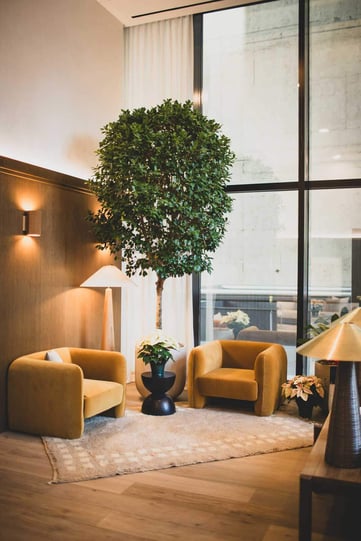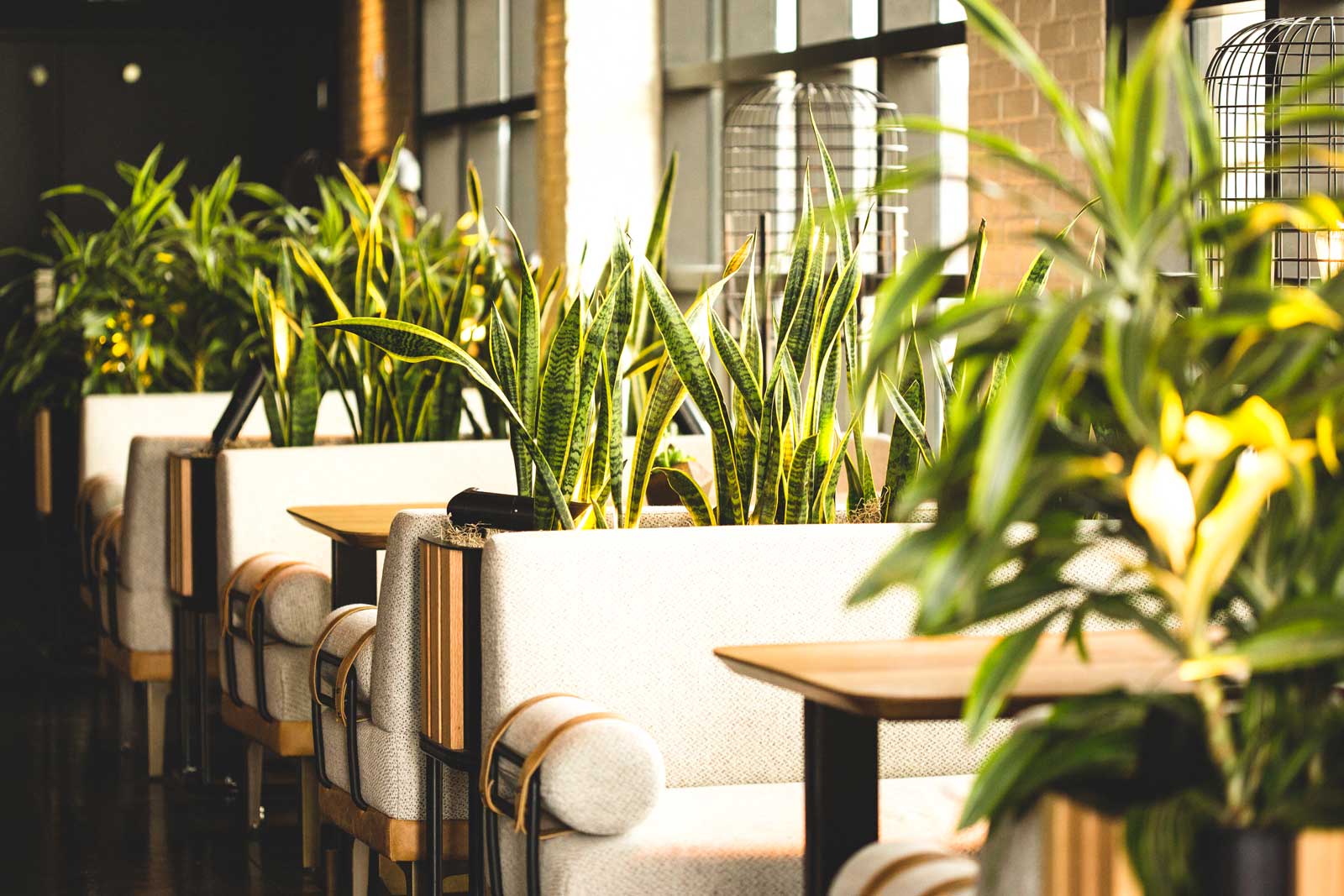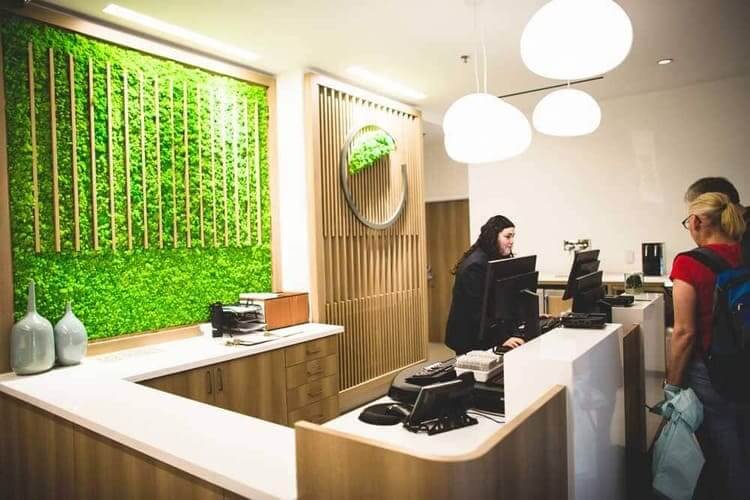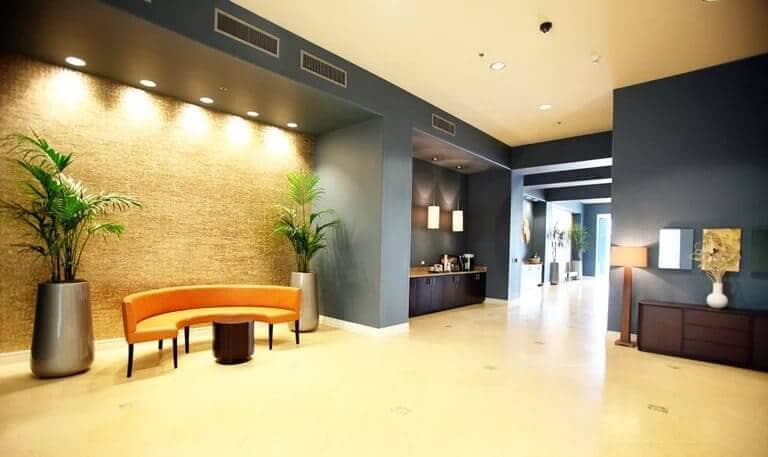Multisensory Biophilic Design: Enhancing the Guest’s Experience
Use plants and other natural elements to give your guests a sensational hotel stay. Here’s how you can create a restorative and immersive hotel environment with a multisensory approach to biophilic design.

Beyond being just another trend in architecture and landscaping, biophilic design has been transformative for the hospitality industry. Biophilic design is all about integrating natural elements into a built environment, a response to humans’ intrinsic need to connect with nature.
This has a multitude of benefits for the hospitality sector, including:
- Reduced maintenance costs
- Mitigated noise pollution
- Enhanced indoor air quality
- Improved guest satisfaction
- A lasting and positive impression
Harnessing the natural power of plants, Natura uses biophilic design to ensure that our plant installations work synergistically with other natural elements used in design. This benefits not just building occupants, but also the businesses we serve.
Biophilic Design for World-Class Hospitality
Incorporating plants into your built environment can have a profound impact on the indoor air quality of your hotel. In fact, a ground-breaking study published in 2023 by the University of Technology Sydney (UTS) found that plants have the ability to efficiently remove toxic fumes and cancer-causing compounds from indoor air.
Research also shows that plant-filled rooms – including those featuring living walls – contain up to 60% fewer airborne molds and bacteria than rooms without plants.There is therefore plenty of evidence to prove that biophilic design significantly improves the air quality in enclosed spaces. It also makes spaces more meaningful by alleviating stress and encouraging relaxation through biophilic elements.
Hotel greenery and indoor plant life has a peaceful and calming effect on guests, driving customer satisfaction and loyalty. A 2017 study that looked at the effect of hotel greenery and indoor plant on customer satisfaction proved that biophilic design establishes a welcoming atmosphere. This entices guests to linger longer (and might even secure a future booking at your hotel).
Of course, biophilic design is not only about the way a space looks. Hotels that effectively incorporate biophilic design will always consider how plants and other natural elements can appeal to people’s full range of senses.
In other words, engaging the five senses (sight, sound, touch, smell and taste) through biophilic design can help you create a fully restorative and immersive hotel environment for your guests.
Using plants and complementary natural elements – like light, water features, and nature sounds – will give you the tools you need to enhance guest satisfaction and wellbeing. It will also put your hotel in prime position to level up against industry competition.
Engaging the Senses Through Multisensory Design
The best kind of hotel stay is one that offers a full sensory experience. There’s a lot more to it than just a place to lay your head. This is why a multisensory approach to landscaping and plant design can be the competitive edge you need to thrive in the hospitality industry.
Using the integration of plant life as a base, here is how you incorporate other natural elements into your design to give your guests a multisensory biophilic experience:
The Music of Nature
Indoor plants and lush living walls naturally absorb sharp, disruptive noises, effectively reducing noise pollution. This contributes to the tranquil environment already established by visually appealing indoor plant life.
Other natural elements like water features can also contribute to a peaceful environment. The sound of flowing water from fountains or waterfalls have a calming effect on hotel guests. Like plants, water drowns out disruptive noise, and works to reduce stress and promote tranquility in a space. For instance, even though the Parkroyal Collection Pickering in Singapore is located in the heart of the city, it uses cascading waterfalls and lush gardens to create a serene oasis for its guests.
Another way to leverage the sounds of nature is to close doors and windows that let in traffic noise and similar disruptive irritants. Rather, and when weather permits, open doors and windows that overlook landscape and lush gardens to bring in natural soundscapes like birdsong or rusting leaves. For example, Playa Viva in Mexico does well to connect its guests with the simple luxury of nature.
A Touch of Class
 Textures are crucial when it comes to biophilic design. Using materials like wood, stone, and wool for furniture, flooring, and decor is one way you can successfully bring the outdoors in. Consider which materials complement the plant species you’ve included in your space, or ask a Natura plant specialist to help you. Our award-winning designers will know when to compare or contrast colors and textures. They’ll also know how to play with textile combinations.
Textures are crucial when it comes to biophilic design. Using materials like wood, stone, and wool for furniture, flooring, and decor is one way you can successfully bring the outdoors in. Consider which materials complement the plant species you’ve included in your space, or ask a Natura plant specialist to help you. Our award-winning designers will know when to compare or contrast colors and textures. They’ll also know how to play with textile combinations.
Like standalone plants or living walls, certain materials provide a tactile connection to nature that can be both comforting and grounding. Clever design can give the same high you might get from walking barefoot on lush green grass or soft sandy beaches. Consult with Natura or another WELL-licensed specialist to take advantage of soft, natural textures that enhance your guests’ connection to nature.
Smell: An Emotive Wellness Tool
Plants already have the power to remove impurities and enhance indoor air quality. So why not take it a step further with scented plants – like lavender, or jasmine – which are known for their calming effects (and are used in aromatherapy).
Alternatively, citrus scents can be invigorating and good for productivity – an excellent morning-time hack to help you wake up a space in a pleasant way that delights guests. Use a diffuser in communal spaces, like a lobby or lounge, to distribute essential oils and other natural fragrances throughout a space quickly and efficiently. Remember, though, to keep fragrances light and neutral. You don’t want certain smells to overwhelm your guests.
A Visual Connection with Nature
 Plants already offer a visually appealing element to biophilic design, which is why it’s important for landscapers, architects and interior designers to work together.
Plants already offer a visually appealing element to biophilic design, which is why it’s important for landscapers, architects and interior designers to work together.
Large windows, for instance, let light in, and can reveal your hotel’s natural landscape or sprawling lawns. Together with indoor plants, natural materials like wood and stone can soften a barren or harsh space, bringing the beauty of nature indoors.
See how Natura used our design expertise to transform the Doubletree Hilton Hotel in San Antonio – another notable hotel to have successfully implemented multisensory biophilic design.
In a way that met our client’s brief and budget, we enhanced the hotel’s guest experience by bringing the outdoors in, finding ways to engage with guests on a multisensory level.
Natura might be experts at visually appealing horticultural design, but don’t underestimate our passion for a full sensory experience. Being able to contribute to an important facet of biophilic design, and seeing clients thrive by leveraging all that biophilia has to offer, means we’re doing our job right.
Short of space and needing a quick-fix solution? Download our smart guide to living walls to see what we can do for you.
Short of space and needing a quick-fix solution? Download our smart guide to living walls to see what we can do for you.




